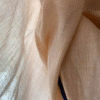Add Some Colour With The Natural Dyes!
“Colors are the smiles of nature.” In the words of famous English poet Leigh Hunt lies some truth that colours add more happiness to our lives and give us an escape from the mundane life. Currently, we are in an era of minimalism where we are inclined towards neutral and simpler tones. White and off-whites are good, but we cannot deny the charms of reds, pinks, and yellows. But the question is, how do we get these beautiful colours naturally? This is how natural dyes come into play. Natural dyes are colourants or solutions obtained from natural sources like plants, fruits, some insects, minerals and even fungi. These dyes have been around for ages before synthetic dyes came into the picture. Lately, people have become aware of the harm that synthetic dyes cause, while natural dyes are preferred nowadays. These dyes are a significant part of sustainable fashion. Let us explore what advantages natural dyes offer: 1. Eco-friendly As discussed earlier, these are extracted from natural resources and, therefore, do not harm the environment. Also, they can easily go with the natural fabrics and give them a beautiful look. Natural dyed fabrics are biodegradable and can be discarded in nature without causing any environmental pollution. 2. Low Environmental Impact Natural dyes are energy and water-efficient compared to synthetic dyes, which require a lot of chemicals and water in processing. This is a major factor that helps naturally dyed fabrics have a low carbon footprint and, therefore, lower environmental impact. 3. No Health Hazards Synthetic dyes and their processing can do much harm to the workers involved as there is more involvement of chemicals. In contrast, natural dyes are safe to work with for dyeing artisans. Naturally dyed fabrics are safer to wear as they are non-toxic and do not cause any harm to your skin. 4.Cultural and Historical Significance Natural dyes have existed for centuries in many parts of the world and hold cultural significance in many societies. In some parts of Africa and Asia, these dyes are often considered sacred, making them a symbol of wealth and spirituality. 5. Unique Artistic Appeal The naturally dyed clothing has a certain texture and appeal that adds authenticity and uniqueness. These dyes add a character to your clothing, which cannot be compared with synthetic ones. Process Of Obtaining Natural Dyes Obtaining natural dyes is mainly a five-step process that results in beautiful colours, causing no harm and making the world brighter and more vibrant. 1. Collection This is the simplest process in which the raw material is collected from its natural source. It might be collected from plants, insects, fungi or minerals. After collecting in good quantity and quality, it is cleaned, dried and stored for further processing. 2. Extraction Extraction is mainly done by either of three processes depending on the properties of the raw material: Boiling: The raw material is put into water and boiled at a particular temperature for a certain amount to obtain the dyed components in the water. It is a controlled process because over-boiling can harm or change the output colour of the dye. Soaking: The raw material is soaked in the water for a prolonged period to get the natural dye seep into the water. Crushing: The raw material is crushed or ground well to release the colour, and then it is soaked in water to create a dye solution. 3. Mordanting Mordant is a dye fixative, an important element to fasten the dye colour. This step ensures the dye colour does not spread or leak. Enhancing colour fastness is an important step in the processing because spillage can cause harm to other fabrics as well. The most common mordants used in the industry today are alum, iron or copper. 4. Dyeing Now, this is the most fun part, where the fabric is immersed in the dye bath and soaked in for a few hours. It should be completely saturated to ensure perfect dyeing. It is to be noted that dye should be heated or set by chemicals to get the best results. 5. Finishing The process of finishing includes rinsing, washing, and drying. Rinsing is done to remove the excess dye, and washing with mild detergent fastens the colour and prevents excess colour spillage. The fabric is then air-dried before doing any more chemical treatments if required. Different Types Of Natural Dyes As discussed previously, there are different sources from where these dyes are extracted. Depending on these sources, the natural dyes are classified. Let us explore more 1. Plant Based Dyes These dyes are extracted from different plant parts like flowers, roots, leaves, or bark. 2. Insect Based Dyes Scale insects are majorly used in producing natural insect dyes. For example, cochineal is a red-coloured dye from an insect found on cacti in Central and South America and kermes dye is derived from an insect found on the bark of oak trees. 3. Mineral Based Dyes Naturally abstained minerals like iron-oxide and copper are used to get rust-coloured dyes and blue & green colour dyes, respectively. 4. Fungi Based Dyes Lichen is the only type of fungi that is used to obtain dye, and this is not highly used in the dyeing industry. At Echo Earth, we promote eco-friendly and sustainable practices, and therefore, we use all the natural dyes extracted from different plants. Here, we will look into the natural dyes we use at Echo Earth. 1. Indigo Plant: Indigofera TinctoriaThe beautiful blue shades are obtained from the plant’s leaves. Indigo is one of the oldest and most widely used natural dyes known to humankind. It was most likely first found in the Indian Subcontinent.Indigo dye is used extensively at echo earth 2. Madder Plant: Rubia Cordifolia The beautiful colours of red and pink are obtained from the plant’s roots. This plant was first found in the regions of the Middle East, Central Asia, and the Mediterranean, but it has also been a significant part of Indian history. This dye is known





